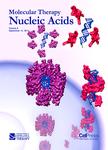版权所有:内蒙古大学图书馆 技术提供:维普资讯• 智图
内蒙古自治区呼和浩特市赛罕区大学西街235号 邮编: 010021

作者机构:Univ Western Ontario Dept Biochem London ON N6A 5C1 Canada Rhein Westfal TH Aachen Dept Neurol D-52062 Aachen Germany Univ Western Ontario Dept Paediat London ON N6A 5C1 Canada Bioinformat Solut Inc Waterloo ON N2L 3K8 Canada Univ Western Ontario Dept Chem London ON N6A 5C1 Canada
出 版 物:《MOLECULAR THERAPY NUCLEIC ACIDS》 (Mol. Ther. Nucl. Acids)
年 卷 期:2025年第36卷第1期
页 面:102442页
核心收录:
基 金:Natural Sciences and Engineering Research Council of Canada [04282, 580241] Canada Research Chairs Canadian Institutes of Health Research Schulich School of Medicine & Dentistry Collaborative Research Seed Grant Huntington Society of Canada Research Chair at Western University
主 题:MT: Non-coding RNAs Huntington's disease HD gene therapy mistranslation missense suppression non-coding RNA polyglutamine polyQ protein aggregation tRNA therapeutics
摘 要:Huntington s disease (HD) is caused by polyglutamine (polyQ) repeat expansions in the huntingtin gene. HD-causative polyQ alleles lead to protein aggregation, which is a prerequisite for disease. Translation fidelity modifies protein aggregation, and several studies suggest that mutating one or two glutamine (Gln) residues in polyQ reduces aggregation. Thus, we hypothesized that missense suppression of Gln codons with other amino acids will reduce polyQ aggregate formation in cells. In neuroblastoma cells, we assessed tRNA variants that misread Gln codons with serine (tRNASerC/UUG) or alanine (tRNAAlaC/UUG). The tRNAs with the CUG anticodon were more effective at suppressing the CAG repeats in polyQ, and serine and alanine mis-incorporation had differential impacts on polyQ. The expression of tRNASerCUG reduced polyQ protein production as well as both soluble and insoluble aggregate formation. In contrast, cells expressing tRNAAlaCUG selectively decreased insoluble polyQ aggregate formation by 2-fold. Mass spectrometry confirmed Ala mis-incorporation at an average level of X20% per Gln codon. Cells expressing the missense suppressor tRNAs showed no cytotoxic effects and no defects in growth or global protein synthesis levels. Our findings demonstrate that tRNA-dependent missense suppression of Gln codons is well tolerated in mammalian cells and significantly reduces polyQ levels and aggregates that cause HD.